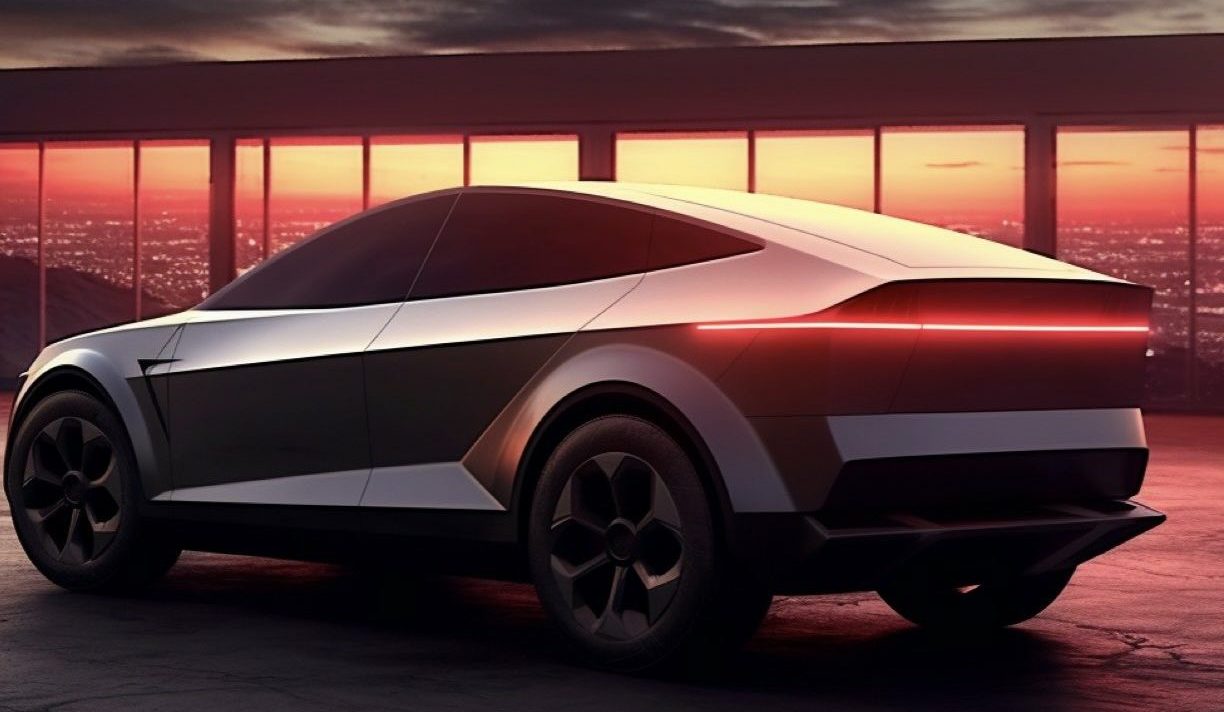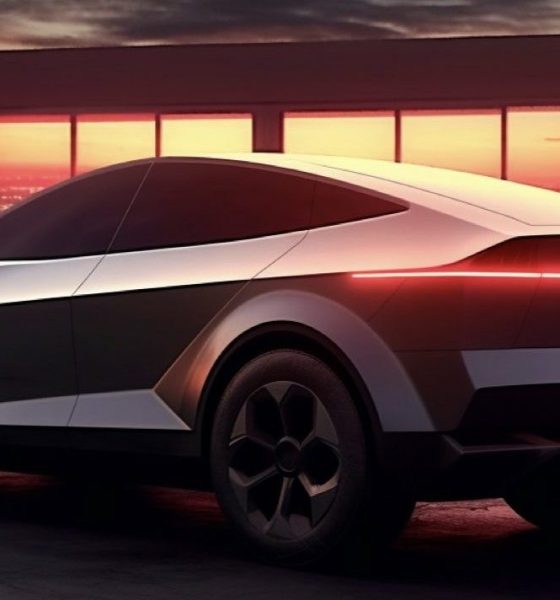

News
Tesla’s $25k car and dedicated robotaxi will be Cybertruck-inspired: report
Tesla’s $25,000 car and the company’s dedicated robotaxi past will both feature a design that’s inspired by the Cybertruck. This was, at least, according to Musk biographer Walter Isaacson.
Citing an excerpt from Isaacson’s upcoming book, Axios noted that Musk was so focused on self-driving robotaxis that it took the collective effort of Tesla executives to persuade him to pursue an affordable car as well. As noted by the publication, the CEO only relented when his aides revealed a plan to build both the $25,000 car and Tesla’s robotaxi side by side.
Tesla is aiming to reach 20 million vehicles per year in 2030. To achieve such a goal, the company would need a vehicle that it could build quickly at scale. This means that Tesla needs a car that would far exceed the Model 3 sedan and Model Y crossover in output. Tesla’s next-generation platform, which was discussed during Investor Day earlier this year, seems designed for this purpose.
As per Isaacson, Musk gathered his top five lieutenants for dinner in Austin for a brainstorming session in November 2021. The agenda for the day was a basic robotaxi that could be produced in high volumes. Musk and his team would reportedly end up debating for almost a year whether they should play it safe and build a car with traditional controls, or opt for a vehicle that’s all-in on autonomy, with no steering wheel or pedals.
Several Tesla engineers reportedly pushed for a more conservative approach. Tesla Chief Designer Franz von Holzhausen, during a meeting on August 18, 2022, even suggested that the robotaxi could be a vehicle with steering wheels and pedals that could be removed later. “If we go down a path of having no steering wheel, and FSD is not ready, we won’t be able to put them on the road,” the Chief Designer said.
Musk, however, was reportedly adamant. “No mirrors, no pedals, no steering wheel. This is me taking responsibility for this decision,” Musk reportedly said. The CEO also highlighted Tesla’s focus on autonomy. “Let me be clear. This vehicle must be designed as a clean robotaxi. We’re going to take that risk. It’s my fault if it f–ks up. But we are not going to design some sort of amphibian frog that’s a halfway car. We are all in on autonomy,” Musk said.
Musk would later relent, however, following a meeting in September 2022. During the meeting, von Holzhausen and several others presented data indicating that a small, “global car” would be needed for Tesla to achieve its ambitious growth targets. The team also convinced the CEO that both the $25,000 car and the robotaxi could be built on the same next-generation platform. Both vehicles could be produced using the same assembly lines as well.
Ultimately, Musk was reportedly convinced of the $25,000 car after von Holzhausen placed models of the $25,000 Tesla and the robotaxi side by side in Tesla’s Design Studio. Both vehicles were unlike other cars on the road today. As per Isaacson, both vehicles had a futuristic design that was inspired by the Tesla Cybertruck. Musk loved the vehicles.
“When one of these comes around a corner, people will think they are seeing something from the future,” Musk said.
Don’t hesitate to contact us with news tips. Just send a message to simon@teslarati.com to give us a heads-up.

News
Tesla starts showing how FSD will change lives in Europe
Local officials tested the system on narrow country roads and were impressed by FSD’s smooth, human-like driving, with some calling the service a game-changer for everyday life in areas that are far from urban centers.

Tesla has launched Europe’s first public shuttle service using Full Self-Driving (Supervised) in the rural Eifelkreis Bitburg-Prüm region of Germany, demonstrating how the technology can restore independence and mobility for people who struggle with limited transport options.
Local officials tested the system on narrow country roads and were impressed by FSD’s smooth, human-like driving, with some calling the service a game-changer for everyday life in areas that are far from urban centers.
Officials see real impact on rural residents
Arzfeld Mayor Johannes Kuhl and District Administrator Andreas Kruppert personally tested the Tesla shuttle service. This allowed them to see just how well FSD navigated winding lanes and rural roads confidently. Kruppert said, “Autonomous driving sounds like science fiction to many, but we simply see here that it works totally well in rural regions too.” Kuhl, for his part, also noted that FSD “feels like a very experienced driver.”
The pilot complements the area’s “Citizen Bus” program, which provides on-demand rides for elderly residents who can no longer drive themselves. Tesla Europe shared a video of a demonstration of the service, highlighting how FSD gives people their freedom back, even in places where public transport is not as prevalent.
What the Ministry for Economic Affairs and Transport says
Rhineland-Palatinate’s Minister Daniela Schmitt supported the project, praising the collaboration that made this “first of its kind in Europe” possible. As per the ministry, the rural rollout for the service shows FSD’s potential beyond major cities, and it delivers tangible benefits like grocery runs, doctor visits, and social connections for isolated residents.
“Reliable and flexible mobility is especially vital in rural areas. With the launch of a shuttle service using self-driving vehicles (FSD supervised) by Tesla in the Eifelkreis Bitburg-Prüm, an innovative pilot project is now getting underway that complements local community bus services. It is the first project of its kind in Europe.
“The result is a real gain for rural mobility: greater accessibility, more flexibility and tangible benefits for everyday life. A strong signal for innovation, cooperation and future-oriented mobility beyond urban centers,” the ministry wrote in a LinkedIn post.
News
Tesla China quietly posts Robotaxi-related job listing
Tesla China is currently seeking a Low Voltage Electrical Engineer to work on circuit board design for the company’s autonomous vehicles.

Tesla has posted a new job listing in Shanghai explicitly tied to its Robotaxi program, fueling speculation that the company is preparing to launch its dedicated autonomous ride-hailing service in China.
As noted in the listing, Tesla China is currently seeking a Low Voltage Electrical Engineer to work on circuit board design for the company’s autonomous vehicles.
Robotaxi-specific role
The listing, which was shared on social media platform X by industry watcher @tslaming, suggested that Tesla China is looking to fill the role urgently. The job listing itself specifically mentions that the person hired for the role will be working on the Low Voltage Hardware team, which would design the circuit boards that would serve as the nervous system of the Robotaxi.
Key tasks for the role, as indicated in the job listing, include collaboration with PCB layout, firmware, mechanical, program management, and validation teams, among other responsibilities. The role is based in Shanghai.
China Robotaxi launch
China represents a massive potential market for robotaxis, with its dense urban centers and supportive policies in select cities. Tesla has limited permission to roll out FSD in the country, though despite this, its vehicles have been hailed as among the best in the market when it comes to autonomous features. So far, at least, it appears that China supports Tesla’s FSD and Robotaxi rollout.
This was hinted at in November, when Tesla brought the Cybercab to the 8th China International Import Expo (CIIE) in Shanghai, marking the first time that the autonomous two-seater was brought to the Asia-Pacific region. The vehicle, despite not having a release date in China, received a significant amount of interest among the event’s attendees.
Elon Musk
Elon Musk and Tesla AI Director share insights after empty driver seat Robotaxi rides
The executives’ unoccupied tests hint at the rapid progress of Tesla’s unsupervised Robotaxi efforts.

Tesla CEO Elon Musk and AI Director Ashok Elluswamy celebrated Christmas Eve by sharing personal experiences with Robotaxi vehicles that had no safety monitor or occupant in the driver’s seat. Musk described the system’s “perfect driving” around Austin, while Elluswamy posted video from the back seat, calling it “an amazing experience.”
The executives’ unoccupied tests hint at the rapid progress of Tesla’s unsupervised Robotaxi efforts.
Elon and Ashok’s firsthand Robotaxi insights
Prior to Musk and the Tesla AI Director’s posts, sightings of unmanned Teslas navigating public roads were widely shared on social media. One such vehicle was spotted in Austin, Texas, which Elon Musk acknowleged by stating that “Testing is underway with no occupants in the car.”
Based on his Christmas Eve post, Musk seemed to have tested an unmanned Tesla himself. “A Tesla with no safety monitor in the car and me sitting in the passenger seat took me all around Austin on Sunday with perfect driving,” Musk wrote in his post.
Elluswamy responded with a 2-minute video showing himself in the rear of an unmanned Tesla. The video featured the vehicle’s empty front seats, as well as its smooth handling through real-world traffic. He captioned his video with the words, “It’s an amazing experience!”
Towards Unsupervised operations
During an xAI Hackathon earlier this month, Elon Musk mentioned that Tesla owed be removing Safety Monitors from its Robotaxis in Austin in just three weeks. “Unsupervised is pretty much solved at this point. So there will be Tesla Robotaxis operating in Austin with no one in them. Not even anyone in the passenger seat in about three weeks,” he said. Musk echoed similar estimates at the 2025 Annual Shareholder Meeting and the Q3 2025 earnings call.
Considering the insights that were posted Musk and Elluswamy, it does appear that Tesla is working hard towards operating its Robotaxis with no safety monitors. This is quite impressive considering that the service was launched just earlier this year.








